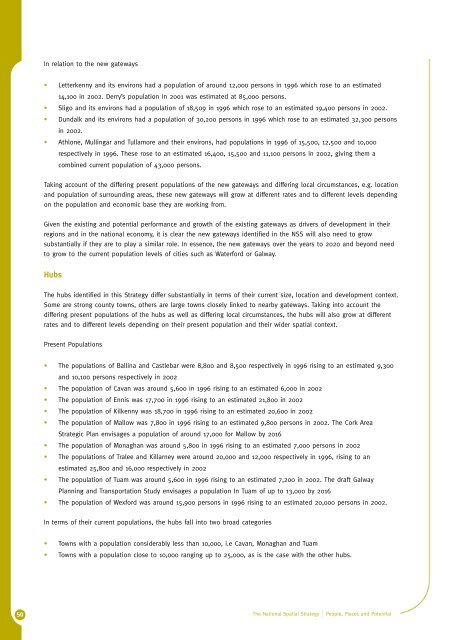National Spatial Strategy For Ireland 2002 - 2020 - Full ... - Kildare.ie
National Spatial Strategy For Ireland 2002 - 2020 - Full ... - Kildare.ie
National Spatial Strategy For Ireland 2002 - 2020 - Full ... - Kildare.ie
Create successful ePaper yourself
Turn your PDF publications into a flip-book with our unique Google optimized e-Paper software.
50<br />
In relation to the new gateways<br />
• Letterkenny and its environs had a population of around 12,000 persons in 1996 which rose to an estimated<br />
14,100 in <strong>2002</strong>. Derry’s population in 2001 was estimated at 85,000 persons.<br />
• Sligo and its environs had a population of 18,509 in 1996 which rose to an estimated 19,400 persons in <strong>2002</strong>.<br />
• Dundalk and its environs had a population of 30,200 persons in 1996 which rose to an estimated 32,300 persons<br />
in <strong>2002</strong>.<br />
• Athlone, Mullingar and Tullamore and their environs, had populations in 1996 of 15,500, 12,500 and 10,000<br />
respectively in 1996. These rose to an estimated 16,400, 15,500 and 11,100 persons in <strong>2002</strong>, giving them a<br />
combined current population of 43,000 persons.<br />
Taking account of the differing present populations of the new gateways and differing local circumstances, e.g. location<br />
and population of surrounding areas, these new gateways will grow at different rates and to different levels depending<br />
on the population and economic base they are working from.<br />
Given the existing and potential performance and growth of the existing gateways as drivers of development in their<br />
regions and in the national economy, it is clear the new gateways identif<strong>ie</strong>d in the NSS will also need to grow<br />
substantially if they are to play a similar role. In essence, the new gateways over the years to <strong>2020</strong> and beyond need<br />
to grow to the current population levels of cit<strong>ie</strong>s such as Waterford or Galway.<br />
Hubs<br />
The hubs identif<strong>ie</strong>d in this <strong>Strategy</strong> differ substantially in terms of their current size, location and development context.<br />
Some are strong county towns, others are large towns closely linked to nearby gateways. Taking into account the<br />
differing present populations of the hubs as well as differing local circumstances, the hubs will also grow at different<br />
rates and to different levels depending on their present population and their wider spatial context.<br />
Present Populations<br />
• The populations of Ballina and Castlebar were 8,800 and 8,500 respectively in 1996 rising to an estimated 9,300<br />
and 10,100 persons respectively in <strong>2002</strong><br />
• The population of Cavan was around 5,600 in 1996 rising to an estimated 6,000 in <strong>2002</strong><br />
• The population of Ennis was 17,700 in 1996 rising to an estimated 21,800 in <strong>2002</strong><br />
• The population of Kilkenny was 18,700 in 1996 rising to an estimated 20,600 in <strong>2002</strong><br />
• The population of Mallow was 7,800 in 1996 rising to an estimated 9,800 persons in <strong>2002</strong>. The Cork Area<br />
Strategic Plan envisages a population of around 17,000 for Mallow by 2016<br />
• The population of Monaghan was around 5,800 in 1996 rising to an estimated 7,000 persons in <strong>2002</strong><br />
• The populations of Tralee and Killarney were around 20,000 and 12,000 respectively in 1996, rising to an<br />
estimated 25,800 and 16,000 respectively in <strong>2002</strong><br />
• The population of Tuam was around 5,600 in 1996 rising to an estimated 7,200 in <strong>2002</strong>. The draft Galway<br />
Planning and Transportation Study envisages a population In Tuam of up to 13,000 by 2016<br />
• The population of Wexford was around 15,900 persons in 1996 rising to an estimated 20,000 persons in <strong>2002</strong>.<br />
In terms of their current populations, the hubs fall into two broad categor<strong>ie</strong>s<br />
• Towns with a population considerably less than 10,000, i.e Cavan, Monaghan and Tuam<br />
• Towns with a population close to 10,000 ranging up to 25,000, as is the case with the other hubs.<br />
The <strong>National</strong> <strong>Spatial</strong> <strong>Strategy</strong> | People, Places and Potential
















